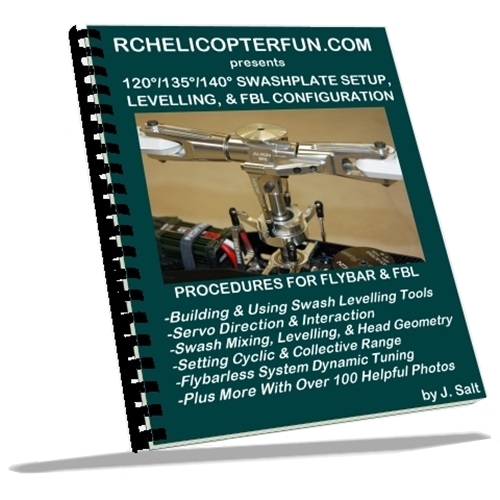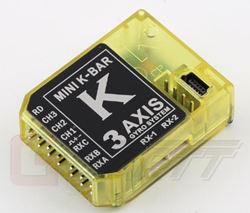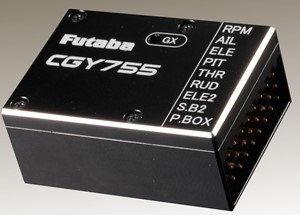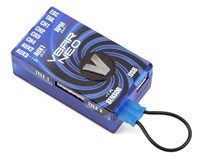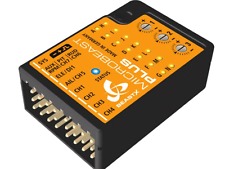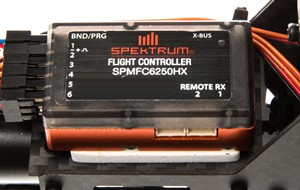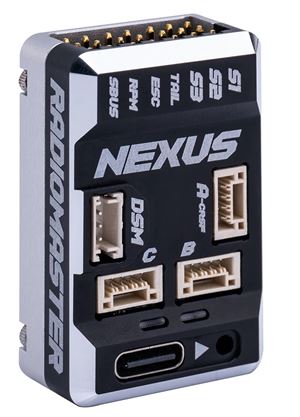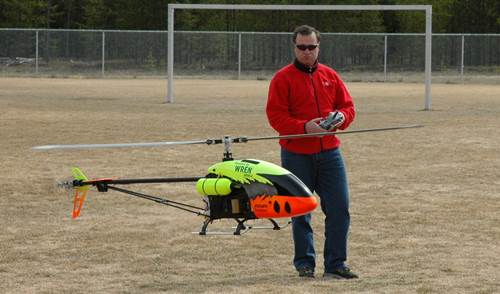Best Flybarless System
Is There Such A Thing?
by John Salt - Updated March 2025
I can’t tell you what the best flybarless system is because that depends on your needs, budget, ease of understanding/comfort level and what ends up "feeling" the best to you while flying.
I can however point out several important criteria to consider when making your choice.
Particular features you might like or dislike such as ease of programming at the expense of customization. On the flip side, lots of customization options making for a more difficult programming, configuration, and tuning process.
As the old adage goes... "Complexity Hampers Execution"
Connectivity for configuration/programming is also another feature to take into consideration.
If you can't easily access your FBL unit once it's in the
helicopter - you better stay away from units that require direct
physical access and choose one that has USB or wireless connectivity.
Receiver compatibility for your particular radio system can also be a feature to look into. Most FBL systems will support standard (PWM) wiring connectivity methods of course, but all better flybarless units are also DSM Spektrum, SBus (Futaba & FrSky), Jeti EX Bus RX etc. compatible through a single communication wiring harness. This simplifies wiring, makes for a "neater" install and with some of the newer systems can also support telemetry from the FBL system back to your radio.
In other words, I don't for a second believe there is one FBL unit that stands head & shoulders above the rest; if there was, we would all be flying it. That of course is not the case. I have setup & flown most of them over the past decade now, and what I can tell you is they all work, and work well if you fully understand how to install, program & configure them.
Make no mistake, flybarless systems
are considered the "heart of the heli" these days. They
have perhaps the single largest impact on the response and behavior of a modern day RC helicopter. It's hard to know which you will like the best
in other words as so much is "feel" dependent.
Hopefully however, my humble little recommendations here will at least give you an idea of what's out there, what to look for, and some general costs & features.
At the bottom of the page, I also give a few more "best flybarless system" feature deciding considerations...
Best Flybarless System Round Up
Mini K-Bar $50.00 USD
For those on a serious flybarless budget, I have to make mention of the Mini K-Bar (or whatever the flavor of name branding of the day chooses to call it).
It's a copy of an older Mikado Mini VBar so if you are not bothered by that, this is in my opinion, the best low cost FBL unit currently on the market.
An excellent performing flybarless unit that supports standard, Spektrum satellite, and Futaba/FrSky S-Bus RX connectivity methods; with basic vibration data logging no less, for under $50 bucks.
Like most copied Chinesium stuff, you have to do a fair amount of digging to find instructions. Because of the lack of out of box instructions, zero customer support, and difficult driver issues, it's not a good beginner / first FBL unit. If you are not computer savvy, it's also not a good choice.
However, for more experienced FBL users who don't mind that lack of support, and want to save money above all else, the cloned Mini VBar, is hard to beat for the price and performance. I find the feel, predictability, and performance on par with some higher end $150+ FBL units I've flown. Like all low cost FBL units however, vibration immunity suffers, so they work best in low vibration environments (electric powered helicopters).
If you want high level FBL performance and features at bottom level pricing, yet don't mind using an older, copied (ripped-off) version of the Mini V-Bar, the Mini K-Bar ticks off those boxes.
Ikon2 Range $120 to $300 USD

MSH Ikon
(also branded as MSH Brain) out of Italy has been one of the most sought after flybarless
stabilization units on the market over the past decade now, being Futaba & FrSky SBus, Spektrum DSM2/X
remote (satellite), and Jeti EX Bus receiver compatible. It's also
one of the best value, higher end units currently on the market right
now in my opinion.
Like many, the Ikon 2 has a rescue feature if you get into trouble while right side up or inverted and become disoriented, the unit will bring you back into a level orientation when told to do so.
The Ikon has one of the best and easiest setup wizards on the market in my opinion.
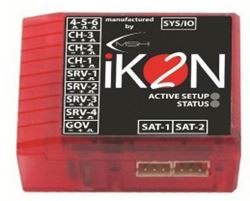
The second generation Ikon2 has basically improved everything the original did well.
Better vibration immunity, faster 32bit CPU, improved and even easier setup wizard, improved true rescue mode, and perhaps the best feature... Flight log data with vibration analysis, and programmable service counters to boot. I love these features.
I started flying with the Ikon2 in 2018 and have to say it is right up there with my other personal favorite, the Bavarian Demon 3X. No question, the Ikon 2 has more features, but I still like the overall feel of the BD 3X a little bit better for my particular flying style. I would however give the logical nod to the Ikon 2 right now for the best value, features and bang for the buck. I fly the Ikon 2 in my T-Rex 800 and a couple 600's - rock solid performance in all three!
MSH Ikon/Brain is one of the only FBL brands that has several models to custom suit every need from smaller micro & mini sizes up to the HD (heavy duty) model. The Standard & HD versions come in both normal or for a little extra money, the bluetooth integrated versions to program direct with a smart device using their app (Android or iOS).
MAXX Electronics ASG System $180 USD
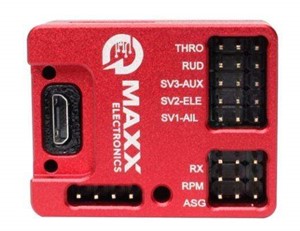
Like the Ikon 2, the MAXX ASG FBL unit offers an affordable, yet top performing FBL system.
I've flown a students helicopter with this unit and it was a joy to pilot and setup was easy with the option to access simple or advanced setup parameters (simple was fine for our purpose).
With 6 sensors (3 gyro, 3 accelerometers) the MAXX ASG has rescue activation, vibration analysis logging and even event logging (RX dropout, RX voltage drops etc).
The MAXX offers excellent thermal stability and high vibration immunity thanks to its fast sampling & filtering algorithms .
Like all the higher end FBL systems listed on this page, the MAXX ASG flybarless flight controller offers multiple modern RC receiver connectivity options (S-BUS/JR-Xbus/UDI/SRXL/SRXL2/SPM4649T/DSM/ExBus); but doesn't support standard RX connectivity (PWM) so if you run an older radio system, pass on the MAXX ASG.
Their Pro version however allows standard PWM, but it doesn't have some other features that the ASG version has.
What is really neat with the MAXX system is their line of accessories to pair with their FBL flight controller such as a hand held programming card, a GPS Autopilot GLONASS module for hands off flying if you are into a zero skill flying experience (if your flying club even allows GPS helicopter systems), or an integrated auto glow ignitor for nitro powered RC helicopters.
Bavarian Demon 3X ($200 USD) Axon ($350 USD)
What can I say - I love Bavarian Demon's FBL systems. I currently use their 3X units in my Trex 700E BlackShark, Bergen Intrepid turbine, Roban 700 Super Scale AS350 & Roban 800 Super Scale EC130. It's hands down the best flybarless system I have flown to date based on my flying style and the overall feel.
Here's my Intrepid on a very windy day with the Bavarian Demon 3X taking out all the "bumps".
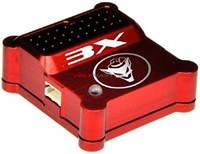
Their older X-series is a pure hi-end meat & pototos flybarless system with no self level or rescue feature. It works really well in big scale helicopters & turbine applications, but is also a decent 3D performer while supporting all swash types and multi bladed heads for the scale crowd.
Bavarian Demon was also the only high performance FBL unit (at least when I was trying to get a firm yes/no answer from several manufacturers) that definitely confirmed their 3X system was 100% turbine friendly and could cope with (filter out) the ultrasonic sound frequencies that mess other FBL gyros up.
I'm fairly certain all the new systems with high sampling rates like the new Bavarian Demon Axon, Ikon2, Futaba CGY's, VBar NEO, MAXX and Spirit are safe turbine choices as well; but if you fly flybarless turbine; definitely double check with the manufacturer to make sure their system will handle the very high frequencies produced by the engine.
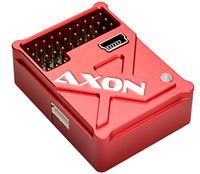
The Axon is their 32 bit processing offering with vibration analysis, rescue, and full governor support which is most likely going to eventually replace the 3X's. The good news with the new Axon on the market, the price of the 3X has dropped making it much more affordable :-)
The 3X is now about $200 USD. The Axon is sitting at $350.00 USD. All the units are encased in a strong aluminum shell (it's stunningly beautiful by the way) & use the latest generation MEMS gyro technology. With full firmware adaptability online download support, the BD's are indeed an impressive FBL choice.
The other nice feature is the USB connectivity input on the 3X Demons are a standard 3 pin servo plug so you can simply use a servo extension wire harness if your unit is hard to gain access to once installed in the helicopter.
Futaba CGY755 & CGY760R $350 to $450 USD
Futaba has for decades made some of the best RC helicopter tail gyros on the market. It's all I used to fly with. My first tail gyro back in 1989 was the Futaba FP G154 and I've flown their G153, GY240 & of course the beloved GY401.
With the advent of flybarless, it only makes sense Futaba also have some of the best flybarless systems on the market.
Many top RC helicopter pilots including Bobby Watts and Alan Szabo Jr. swear by Futaba's flybarless gyros and for good reason.
Futaba's two latest flybarless systems include the CGY755 and the CGY760R. The main difference between the two is the 760R includes both T-FHSS & FASSTest protocol built in receivers, whereas the 755 doesn't.
Both units are encased in a strong full aluminum shell offering good vibration immunity and as such can be used in nitro, gas, electric, and turbine powered models.
Flybarless system programming is by way of Futaba's separate GPB-1programming box. This is somewhat of a negative requiring a secondary piece of rather costly support equipment, but that is just my opinion. I know many people who can't stand hooking their helicopters up to a laptop every time and a small hand held programming box is more convenient. It totally depends on your programming interface preference.
Pricing is high when compared to the competition at $400 USD for the CGY755 and $450 USD for the CGY760R, but that includes the GPB-1 programming box. Knock $50 bucks off each if you already have a GPB-1 box bringing them down into the Bavarian Demon realm, not to mention the separate Futaba RX cost saving with the 760R.
Mikado VBAR NEO $220.00+ USD
The Mikado VBAR NEO series of flybarless systems out of Germany are a popular and performance minded choice.
Quite a few RC heli pilots passionately feel the VBAR is the best flybarless system out there "bar" none (pun intended). Their NEO series of FBL units will also communicate fully with Mikado's line of VControl radios.
This allows you to use the setup wizard direct through the radio to the flybarless unit meaning no laptop or smart phone is needed for FBL setup. Parameters can even be changed on the fly through the radio along with firmware updates. For some, this direct radio to FBL unit programming and configuration is very convenient.
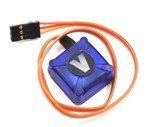 VBAR NEO Remote Gyro Sensor Unit
VBAR NEO Remote Gyro Sensor UnitThey also give you the option to use their external gyro sensor unit where unique sensor mounting locations are required.
The VBAR NEO is the only remaining FBL system on the market that allows this "external sensor" option.
There is no doubt the VBAR will continue to be a popular choice because, just as with most of these systems, the software keeps getting tweaked and allows so much setup flexibility and convenience if using a Mikado VControl radio.
Of course, the 3 big name radio manufacturers are fully supported with the Mikado VBAR systems acting as your RX being both Futaba & FrSky SBus friendly as well as Spektrum & JR DSM2/X satellite receiver friendly.
MicroBeast Plus $180.00 USD
The MicroBeast Plus/Ultra & MicroBeast Plus HD by BeastX (again out of Germany) is another FBL system that many pilots consider to be the best flybarless system currently on the market from an ease of use/programming standpoint for newbies. I agree with that.
Fully Spektrum/JR DSM2/X remote RX and Futaba S-Bus compatible in a single contained unit - again showing the direction this technology is heading.
As I already mentioned, I personally feel it is one of (if not the) best flybarless system for people's first introduction into virtual flybars due to its out of the bag plug and play simplicity along with easy to understand setup instructions & intuitive LED programming method direct on the unit.
BeastX also gives the option to use the StudioX App for PC/Mac/Smartphone/Tablet in combination with the optional USB2SYS or BLE2SYS interface to get even more out of the BeastX such as saving/restoring parameters, firmware updates, loading preset heli configurations and making advanced adjustment to fully customize Microbeast Plus/Ultra. However and in my opinion, one the best features of the Microbeast all along has been the easy to use built in programming interface so you don't need any of this extra stuff.
I've flown a good number of RC helicopters using the MicroBeast and find the feel and performance fairly good given the easy & straightforward setup procedure using nothing more than your transmitter sticks along with the push button, menu / status LED's, and 3 adjustable pots on the unit.
Some call this "old school" programming; I call it "hassle free field friendly" programming.
Spektrum AR7210BX $200.00 USD
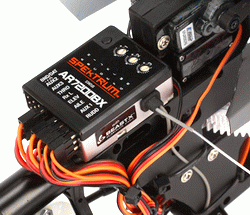
Spektrum teamed up with BeastX, offering their AR7210BX 8 channel receiver which is essentially an 8 channel DSMX Spektrum receiver with the MicroBeast flybarless system built in with provision for one additional satellite Spektrum RX.
The AR7210BX has been discontinued, replaced by the FC6250HX, but I'm leaving it up on my list for a while since there is still stock available, and it's been such a popular unit so there is no question they will be prevalent in the used market for years to come.
For about $200 USD new and half that used, the AR7210BX is still a great value option if you fly with a Spektrum, JR, or multi-protocol DSM2/X radio and want to get a combination RX and flybarless stabilization unit to save a little money over getting two separate components not to mention make for a cleaner and simplified install.
I have flown a fair number of student's and customer's helis that used the first gen AR7200BX, and now the updated AR7210BX. Just like the MicroBeast Plus, I find them to be wonderful units that are easy to setup. I've gotten very comfortable with the "on face" button/LED setup & programming procedure on them which is really nice if you don't like hooking stuff up to a computer or linking it to an external device.
Spektrum SPMFC6250HX $ 200.00 USD
Spektrum's SPM FC6250HX flybarless flight controller uses their own AS3X and SAFE stabilization technology we have been accustomed to on Blade's smaller flybarless helis for years now.
It works well for all flying styles ranging from 3D, F3C, Scale & beginner; on sizes from 250's right up to 700's.
Like many modern FBL systems, the FC6250HX utilizes both a 3 axis gyro and 3 axis accelerometer IMU (internal measurement unit) delivering feedback through a 32 bit processor using advanced stabilization algorithms to deliver predictable flying characteristics. A bottom aluminum case half is used over plastic to increase mass density helping out in higher vibration environments.
Over and above DSM2/X remote receiver connectivity, the FC6250HX works with Spektrum's new SRXL2 serial protocol RX's and ships with a SRXL2 4651T RX.
Other proprietary Spektrum/Blade/Horizon Hobby connectivity technology includes Smart (ESC & Battery), Spektrum telemetry, and forward programming of the flybarless flight controller through compatible Spektrum radios (transmitters).
A good FBL flight control system for Spektrum only users, but due to it's proprietary Spektrum/Blade/Horizon technology, not the best flybarless system for users of different and more cost effective alternatives IMO.
Spirit System $225 USD
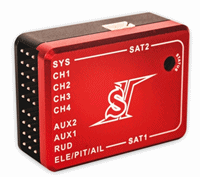
The lineup of Spirit System's FBL units have been growing in popularity over the past few years and are fast becoming the most popular FBL choice among many of my visitors that have contacted me.
So on their many enthusiastic recommendations, it has been added to my best flybarless system list, but I have not personally flown this system yet.
Spirit has 3 different flybarless systems to choose from based on your particular needs from the tiny uSpirit that will work with 130 to 250 size helicopters, up to their newest Spirit 2 that will work with 250 to 800 size machines.
Spirit's lineup utilizes fast and powerful dual core 32 Bit ARM processors and have intelligent vibration analysis, data logging, along with rescue/bail out which by all accounts is very similar to Bavarian Demon's rescue algorithms. Setting a hard deck and geolink safe flying envelope / return to home options as well with their GPS add on module.
Price wise, they are competitive with the other high end brands in the $200 to $250 range.
Customary RX, Spektrum Satellite, Futaba & FrSky SBUS, and Jeti Duplex XBUS connectivity is supported. Radio configuration programming integration is also possible with Spektrum Airware, Jeti Duplex, OpenTX, and Graupner. This integration makes it possible to configure/program your FBL unit's settings direct from your radio instead of hooking it up to a computer.
When hooked up to a computer, the setup wizard software is easy and intuitive to use with many popular helicopter models already pre-configured into the data base. The software is available for more platforms than any other FBL unit on the market (Windows, MacOS, Linux, Android, iOS, WP, SailfishOS, FreeBSD, Raspberry Pi and more).
Smartphone or tablet connectivity is available through WiFi or Bluetooth which is built into the units and is not an optional add-on for extra cost like some other systems. ESC telemetry is also supported with Castle, HobbyWing, Scorpion & Kongtronic ESC's that support telemetry output.
RotorFlight - Open Source $ Price Varies
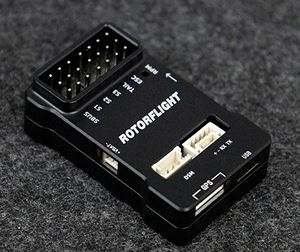
For those multi-rotor pilots out there who are familiar with BetaFlight, or those of you who want to dive into the deep end of opensource FBL systems, RotorFlight is for you!
RotorFlight is an entirely open-source project FBL system meaning its price is very attractive as are its capabilities & features.
This also means a RotorFlight flybarless system requires a high level of understanding. Not only that of the system which you can build with your own components or purchase ready built like the example pictured above, but you also have to understand all the concepts of flight controllers as they apply to single rotor RC helicopters.
Requirements include programming skills, understanding helicopter control physics inside & out, basic understanding of IMU systems (gyros and accelerometers), how to correctly program and tune PID systems, main & tail rotor RPM vibration/ resonance filtering understanding and if you build your own units, soldering and electronic skill sets. Naturally you have to be a good RC helicopter pilot as well to correctly tune everything afterward to actually get your helicopter/s flying well.
In short, a large time investment and for me at this stage in my life, I will personally stick with off the shelf FBL systems that have been painstakingly configured and perfected over the years; only using what I know and trust. I don't want to beta test. But for those of you who do, no question, RotorFlight represents top level opensource FBL nerdvana.
Here's a link to RotorFlight's home page if you wish to learn more about it.
RadioMaster NEXUS FBL SYSTEM $80 USD
With all that said about the complexities of RotorFlight configuration, there's a solution.
RadioMaster's very own RotorFlight based NEXUS FBL system; this one has the potential to be a game changer!
This is the first RotorFlight based FBL system, that has gone through a year of testing & development by RadioMaster and many RC helicopter pilots.
NEXUS offers all the benifits of an open-source RotorFlight based FBL system, yet like all the other big name brand FBL systems, has had all the hard & time consuming testing work done for us.
The NEXUS doesn't have a traditional PWM RX connectivity option so pass if you have an older receiver/s without serial port/s. It however supports most serial RX communication protocols through a dedicated DSM port for Spektrum folks, an SBUS port plus 3 UART (universal asynchronous receiver/transmitter) ports for CRSF, ELRS, GHOST, SUMD, IBUS, XBUS, EXBUS, PPM, MSP and F PORT. Add in good protocol future proofing thanks to it's open-source flexibility.
At only $80 USD, the RadioMaster NEXUS is the first full CNC aluminum cased, high-end, high performance FBL system that costs under a hundred bucks!
I predict this opensource RC helicopter flight control system is going to cause huge ripples in the months and years to come, exactly the same way RadioMaster's open-source Open/EdgeTX computerized radio systems have.
I know I can't wait to try it out, and if it flies as well as many of the beta testers are telling me and is fairly easy to setup out of the box - this might be my new favorite FBL unit moving forward - stay tuned...
More Thoughts On Best Flybarless System Features & Rescue Modes
As you can see, the continuing trend and holy grail of
flybarless stabilization right now is to create systems that respond
with the predictability and consistency of a flybar, yet give that
"tracking on rails" flight experience.
Ease of setup is another big direction push with all these systems (most now coming with very good setup wizards / configurators) and their subsequent firmware and model updates.
The other obvious direction FBL stabilization is headed is towards stand alone units that act as both the FBL stabilization system and the receiver. Either by using an internal receiver, or by having the ability to plug in a small satellite receiver/s, or small communication networking SBus/EX Bus/UART based receivers to make the install easier, more attractive and enable telemetry.
Additional bells & whistles such as rescue modes, self-leveling, hard deck, mobile device connectivity, radio system integration programming connectivity, and flight log/vibration analysis will undoubtedly continue to grow in popularity.
Smaller form-factors and increased processing power & speed round out the trends with most of the higher end units now all utilizing 32 bit architectures.
One common question I get is if a lower cost airplane stabilization system could be used in a helicopter (for cost saving reasons). The answer is absolutely not. Helicopters are a completely different animal with things like eCCPM mixing, torque compensation, torque direction settings, revolution mixing, pirouette compensation, main & tail rotor RPM vibration & resonance PID filtering, all kinds of settings related to pitch (both tail and main blades) to name just a few heli specifics, and naturally totally different algorithms to control them all.
I get just as many emails about why I don't specifically recommend one system over the other, or why I say I like some more than others. I also get asked very often if I feel rescue or bail out features are worth the extra cost. Here are my "filtered downed" responses to these questions:
"Rescue & Bailout" are certainly useful for some, but I find them more of a gimmick after having used several now. I of course have been flying for many years and I know my flying limits very well and I have no interest in pushing my limits anymore, so I very rarely get into a situation where I would need to use them. The largest draw back I find with them is you have to consciously activate the rescue or bailout feature (assigned to a toggle switch) when you get into trouble before the ground interferes.
Generally, if you are close to the ground (totally depending on the attitude/speed of the aircraft of course), you may not have time to do that if you get into trouble as things start going sideways really fast and you're filling your underwear at the same time. If you're higher up, then you will have time to active it, but you may also have time to save it yourself which will build important skills. It really depends on how you learn, and what you feel is important.
Some swear by rescue modes, others could care less. No question, if it saves just one crash on a larger helicopter, it just paid for the extra cost of the unit. In short, if you think rescue is a good feature to have, then I would say it's definitely worthwhile to get. As the old saying goes, it's better to have a parachute and not need it, than to need it and not have it :-)
They will give you more confidence, but that confidence in rescue modes can work both ways if you continually start flying well beyond your ability solely relying on the "save" button all the time. That type of reliance will eventually lead to a crash. Again, so much depends on how you fly, how you learn, and how you use the rescue mode.
Another bit of advice if you have an FBL unit with rescue, is to PRACTICE using it (under controlled situations) so when you do need to use it, you're not panicking & fumbling around trying to recall what toggle switch you have rescue assigned to (remember, you're very likely filling your underwear at this moment). You want the reaction time between when your bird is getting out of shape to when the toggle is activated to be as fast as possible, and that requires intimate familiarity / muscle memory with the activation process.
In addition to using that save toggle to get familiar with it, if you have several helicopters with rescue modes, make sure you program the same toggle for rescue for every model. I know that is fairly common sense stuff, but when you're new to all this, it might not be obviously apparent at first.
As for why I like BD & Ikon over the others when I say they ALL WORK WELL... You will find after using and setting up several FBL units, you will just instinctively gravitate to some of them. I personally like BD the best of all the ones I've tried to date due to the overall "feel" of it. Some love the feel of the BD, others don't. Moreover, learning to configure FBL units and their various setup wizards and features is a VERY TIME CONSUMING process so once you get comfortable with a system, you tend to stick with it. BD's & Ikon's wizard, features, and feel just hit a cord with me that I find very usable.
Not everyone feels the same way,
and this again is why I don't & never will recommend any one FBL
unit over the others. It would be a disservice to you. I personally think all the big name FBL units
these days are fantastic stabilization systems after using many of them.
Finally and if you are an FBL newbie, consider what specific flybarless / flight controller system/s are being used in your area or flying club (local familiarity in other words). Using a system that is popular in your area or club has the advantage of getting experienced setup/tuning help should you need it.
When choosing your best flybarless system, it comes down to the three F's...
Features, Feel, & Familiarity.
Price can be thrown in there as well ;-)
